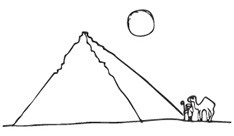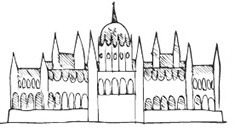3.1.
3. lecke Mennyibe kerül?
Numbers, age, prices, shopping in a cafe
Pages 12-15 in the printed book
Dialogue 1.
In this dialogue someone is buying something to eat in the cafe. Notes on dialogue 1:
- The speakers use formal language which appears in the greeting forms. Jó napot kívánok! can be used throughout the day so it can be translated as Good morning. or Good afternoon.
- Tessék! may have several meanings. In this dialogue it is used twice:
1) it means How can I help you? or What would you like to have?
2) when the shop assistant gives the sandwich to the customer it means Here you are.
- Mennyibe kerül? means How much is it? and this should be learned as a phrase rather than focusing on the meaning of the individual words of the sentence.
- ez (this) and az (that) are demonstrative pronouns, which can be used to point at something
- The verb kér is used very often in cafes, bars, pubs or restaurants when we order something. This verb is used in a conjugated form kérek (literally: I ask for) and the food or drink gets an ending (which will be discussed later)
- Köszönöm. means Thank you. and there are more ways to answer:
1) Nincs mit. (That’s all right. or No problem.)
2) Én is köszönöm. is used when you are also grateful to the other person (literally it means: I also thank you.)
3) Szívesen. (You’re welcome.)
 |
|
|
– Jó napot kívánok! |
– Good morning. |
Dialogue 2.
In this dialogue a lady buys some ice cream with her 2-year-old daughter. The ice cream seller gives a little gift to the girl. Notes on dialogue 2:
- there are two words in Hungarian for ice cream:
1) fagylalt is made by ice cream parlours or pastry shops themselves and is sold in scoops
2) jégkrém is sold in boxes or on sticks in supermarkets
- The mother says Köszönjük. (literally: We thank you.)
 |
|
|
– Jó napot kívánok! |
– Good morning. |
Dialogue 3.
In this dialogue a young boy buys a drink in a bar or pub. The legal drinking age in Hungary is 18 and if you would like to buy alcohol in a shop or in a bar and you look young you may be asked to prove your age. In Hungary you must always have an identity document available, which may be an ID card, a driving license or a passport. These documents can be used also to prove your age when buying alcohol. In this dialogue the barman wants to see the boy’s ID card when he orders a beer. The barman uses informal language with the boy, which is very common in bars. Notes on dialogue 3:
- jó means good but it is very often used to express agreement or approval (meaning All right. or OK)
 |
|
|
– Mit kérsz? |
– What would you like to have? |
3.2.
Numbers
Page 13 in the printed book
|
1 egy |
18 tizennyolc |
51 ötvenegy |
3.3.
Asking about the price
Page 14 in the printed book
Here we can practice how to ask about the price. Mennyibe kerül a/az … means How much is the …
|
|
– Mennyibe kerül a rágó? – Mennyibe kerül a csoki? – Mennyibe kerül a tea? – Mennyibe kerül a kóla? – Mennyibe kerül a kávé? – Mennyibe kerül a sajtos szendvics? – Mennyibe kerül a pogácsa? – Mennyibe kerül a hamburger? |
| Árjegyzék (Price list) | |
| rágó (chewing gum) | 250 |
| csoki (chocolate) | 240 |
| tea | 220 |
| kóla (0,5 l) | 350 |
| kávé (coffee) | 260 |
| sajtos szendvics (cheese sandwich) | 300 |
| pogácsa (savory scone) | 170 |
| hamburger | 540 |
3.4.
Ordering in a cafe
|
rágó |
 |
rágót |
The words that appear here have a -t ending (rágó – rágót, csoki – csokit etc.). The -t ending may be preceded by a linking vowel. This is the accusative ending which has to be added to the nouns when used with the verb kér (ask for something). More details about the accusative ending will be presented later (Unit 15).
We can use the verb kér with the accusative form of nouns (in this exercise drinks and snacks) to ask for things. This is the easiest and most common way to order something. The verb is used in first person singular form (kérek – I ask for something).
| – Tessék! – Kérek egy sajtos szendvicset és egy kólát. – 650 forint. – Tessék. – Köszönöm. *** – Tessék! – Kérek egy csokit és egy rágót. – 490 forint. – Tessék. – Köszönöm. *** – Tessék! – Kérek egy kávét és egy pogácsát. – 430 forint. – Tessék. – Köszönöm. *** – Tessék! – Kérek egy teát és egy sajtos szendvicset. – 520 forint. – Tessék. – Köszönöm. *** – Tessék! – Kérek egy hamburgert és egy kávét. – 890 forint. – Tessék. – Köszönöm. |
3.5.
Talking about your age
Page 15 in the printed book
The question How old are you? can be translated into Hungarian as Hány éves? (formal) or Hány éves vagy? (informal). In these sentences the question word Hány? means How many? and éves means years old. The answers also must include éves. (én) (te) and (ő) are in brackets because personal pronouns do not appear in neutral sentences.
Életkor (age): 33 év (33 years)
(Én) harminchárom éves vagyok. (I’m 33 years old.)
(Te) harminchárom éves vagy. (You’re 33 years old.)
(Ő) harminchárom éves. (He/She is 33 years old.)
Életkor (age): 50 év (50 years)
(Én) ötven éves vagyok. (I’m 50 years old.)
(Te) ötven éves vagy. (You’re 50 years old.)
(Ő) ötven éves. (He/She is 50 years old.)
Életkor (age): 19 év (19 years)
(Én) tizenkilenc éves vagyok. (I’m 19 years old.)
(Te) tizenkilenc éves vagy. (You’re 19 years old.)
(Ő) tizenkilenc éves. (He/She is 19 years old.)
Életkor (age): 26 év (26 years)
(Én) huszonhat éves vagyok. (I’m 26 years old.)
(Te) huszonhat éves vagy. (You’re 26 years old.)
(Ő) huszonhat éves. (He/She is 26 years old.)
Hány éves? may refer to a person (formal you / he / she) or an object (it). It can mean: 1) How old are you? (formal) 2) How old is he / she? 3) How old is it?
The answer to this question includes éves (years old) and there is no verb in the sentence.
 |
|
A perui Machu Picchu hatszáz éves. |
 |
|
Az egyiptomi Kheopsz-piramis négyezer-ötszáz éves. |
 |
|
A Föld kb. négy milliárd éves. |
 |
|
A szomszéd kislány négy éves. |
 |
|
Ez az autó negyvenöt éves. |
 |
|
A budapesti Parlament százhúsz éves. |